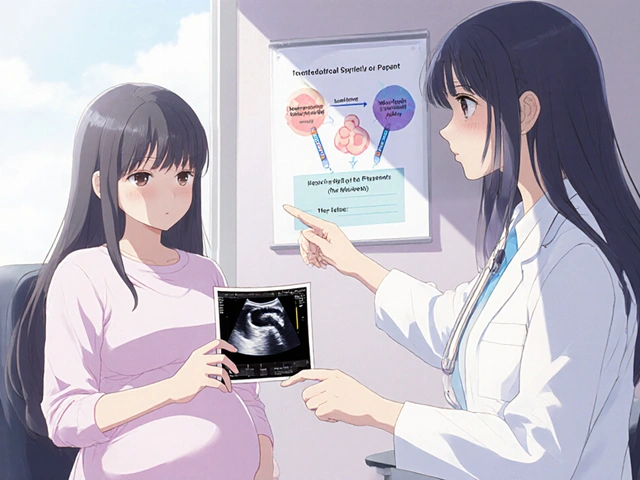Angioedema is a temporary swelling of deeper layers of skin and mucous membranes that often brings sharp pain and tightness. When the swelling hits the lips, throat, or limbs, the sensation can feel like a pressure cooker ready to explode. The good news? A mix of medication, trigger‑control, and simple self‑care can turn those flare‑ups into manageable bumps.
TL;DR - Quick Relief Checklist
- Apply a cool compress for 10‑15 minutes to dull the pain.
- Take a fast‑acting antihistamine (e.g., cetirizine 10mg) at the first sign of swelling.
- If you have a prescription, use a bradykinin blocker such as icatibant within 30minutes of onset.
- Track stress, alcohol, and ACE‑inhibitor exposure; avoid known triggers.
- Maintain a hydration‑rich diet and get 7‑9hours of sleep to keep mast‑cell activity low.
Understanding the Pain Behind Angioedema
Two chemical pathways dominate the pain response:
- Bradykinin is a peptide that expands blood vessels, increasing fluid leakage and causing a burning, deep‑tissue ache.
- Histamine released from mast cells triggers a more surface‑level itching and itching‑combined sting.
In hereditary forms, a C1 inhibitor deficiency leads to unchecked bradykinin production, which is why attacks feel so intense.
Common Triggers That Amplify Discomfort
Identifying what lights the fuse is half the battle. The most frequent culprits include:
- ACE inhibitors - medications for hypertension that block the breakdown of bradykinin.
- Stress - cortisol spikes prime mast cells to release histamine and bradykinin.
- Physical trauma or dental procedures that irritate the tissue.
- Heat, alcohol, or certain foods (e.g., nuts, shellfish) that a few patients report as personal triggers.
Acute Relief: Medications That Work Fast
When an attack starts, speed is everything. Below is a side‑by‑side look at the most commonly used options.
| Medication | Mechanism | Onset of Relief | Typical Use | Key Pros / Cons |
|---|---|---|---|---|
| Antihistamines | Block H1 receptors, limiting histamine effects | 15‑30min | Mild to moderate swelling, especially with allergic trigger | Easy OTC; less effective for bradykinin‑driven pain |
| Corticosteroids | Suppress overall immune response | 30‑60min (IV) or 2‑4h (oral) | Severe or prolonged attacks | Powerful; risk of systemic side‑effects if overused |
| C1‑esterase inhibitor concentrate | Replaces missing C1 inhibitor, curbing bradykinin | 30‑45min (IV) | Hereditary angioedema (typesI/II) | Targeted; requires prescription and infusion |
| Icatibant | Selective bradykinin B2‑receptor antagonist | 5‑10min subcutaneously | Rapid relief for HAE attacks | Fast; injection site pain possible |
For most patients, starting with an OTC antihistamine and a cool compress buys time. If the swelling is linked to hereditary angioedema or you have a prescribed bradykinin blocker, use it as soon as you notice the flare.

Beyond Pills: Self‑Care Techniques That Lower Pain
Medication stops the fireworks; lifestyle keeps the fuse from sparking again.
- Cold compresses: 10‑15minutes, three times per hour, reduces nerve firing and fluid leakage.
- Elevation: If limbs are affected, keep them raised above heart level to aid venous return.
- Mind‑body tools: Guided breathing, progressive muscle relaxation, or short meditation sessions lower cortisol, which in turn calms mast‑cell activity.
- Hydration & low‑salt diet: Excess sodium can worsen fluid retention, making swelling feel tighter.
- Trigger journal: Record foods, meds, stress episodes, and weather changes. Patterns emerge quickly, allowing pre‑emptive avoidance.
Connecting Angioedema to the Bigger Picture
Angioedema sits inside a network of related conditions and concepts:
- Hereditary angioedema (HAE) - a rare genetic disorder where C1‑inhibitor deficiency drives relentless bradykinin production.
- Acquired angioedema - often linked to ACE inhibitors or autoimmune diseases.
- Quality of Life (QoL) - repeated attacks can cause anxiety, missed work, and social withdrawal.
- Psychological support - counseling or CBT can help patients re‑frame fear of attacks.
Understanding these links helps you discuss a comprehensive plan with your clinician, rather than focusing on a single symptom.
When to Seek Emergency Help
Any swelling that involves the throat, tongue, or lips can threaten the airway. Call emergency services if you notice:
- Difficulty speaking or swallowing.
- Stridor (high‑pitched breathing sound).
- Rapidly expanding swelling within minutes.
Even if pain feels manageable, airway compromise can happen silently.
Putting It All Together - A Personal Action Plan
- Identify your trigger profile: Use a journal for two weeks; note medication changes, stress spikes, and diet.
- Build a rescue kit: Keep an antihistamine, a cool compress pack, and any prescribed bradykinin blocker at home, work, and in your bag.
- Practice rapid response: At the first sign of swelling, start the cold compress, take the antihistamine, and if you have a prescription, administer it per your doctor’s instructions.
- Schedule quarterly reviews: Discuss attack frequency, medication effectiveness, and new triggers with your specialist.
- Invest in stress‑reduction: Even a 10‑minute daily breathing routine can shave down cortisol levels enough to lower attack odds.
Following these steps transforms a reactive nightmare into a proactive routine.

Frequently Asked Questions
What is the fastest way to reduce angioedema pain?
A subcutaneous dose of icatibant works within 5‑10 minutes, directly blocking the bradykinin receptor that drives deep tissue pain. If you don’t have a prescription, a cool compress plus a high‑dose antihistamine can start easing discomfort in under 30 minutes.
Can over‑the‑counter antihistamines help with hereditary angioedema?
They may provide modest relief if histamine plays a secondary role, but they do not target the bradykinin pathway that dominates HAE. Relying solely on antihistamines can delay the use of more effective therapies like C1‑esterase inhibitor concentrate or icatibant.
Why does stress worsen my angioedema attacks?
Stress triggers cortisol release, which in turn activates mast cells and can increase bradykinin production. The combined effect leads to more fluid leakage and sharper pain. Managing stress therefore cuts down both the frequency and intensity of episodes.
Are ACE‑inhibitor drugs a common cause of angioedema?
Yes. ACE inhibitors block the enzyme that degrades bradykinin, causing it to accumulate and provoke swelling, especially around the face and lips. If you’re on an ACE inhibitor and develop angioedema, discuss alternative blood‑pressure meds with your physician.
What lifestyle changes can lower my attack frequency?
Avoid known triggers (ACE inhibitors, alcohol, extreme heat), maintain a balanced low‑salt diet, stay well‑hydrated, and adopt daily stress‑reduction techniques like meditation or yoga. Keeping a symptom diary helps you spot hidden triggers quickly.
When should I call emergency services during an attack?
If swelling involves the tongue, lips, or throat and you experience difficulty breathing, speaking, or swallowing, seek emergency care immediately. Airway blockage can develop fast, even if pain feels tolerable.
Can regular exercise help with angioedema?
Moderate, consistent exercise improves circulation and reduces stress hormones, both of which can lessen the severity of attacks. However, avoid extreme heat or very intense workouts that might provoke flushing or dehydration.





Comments (10)